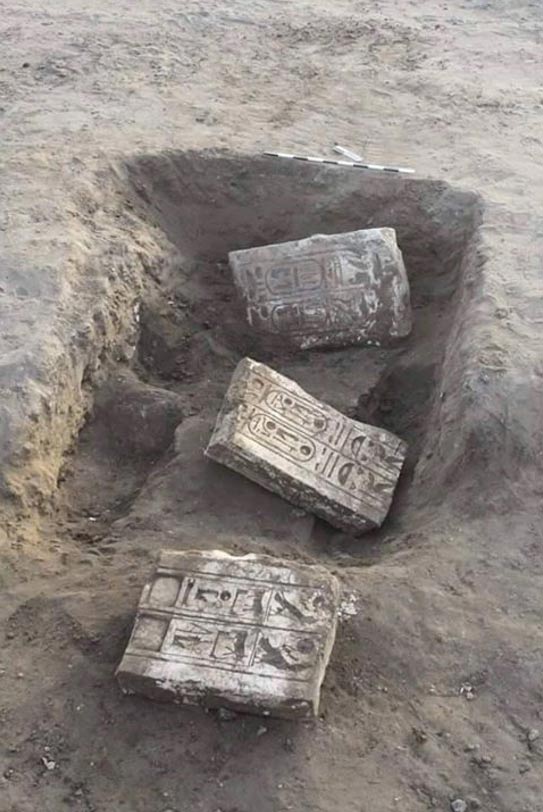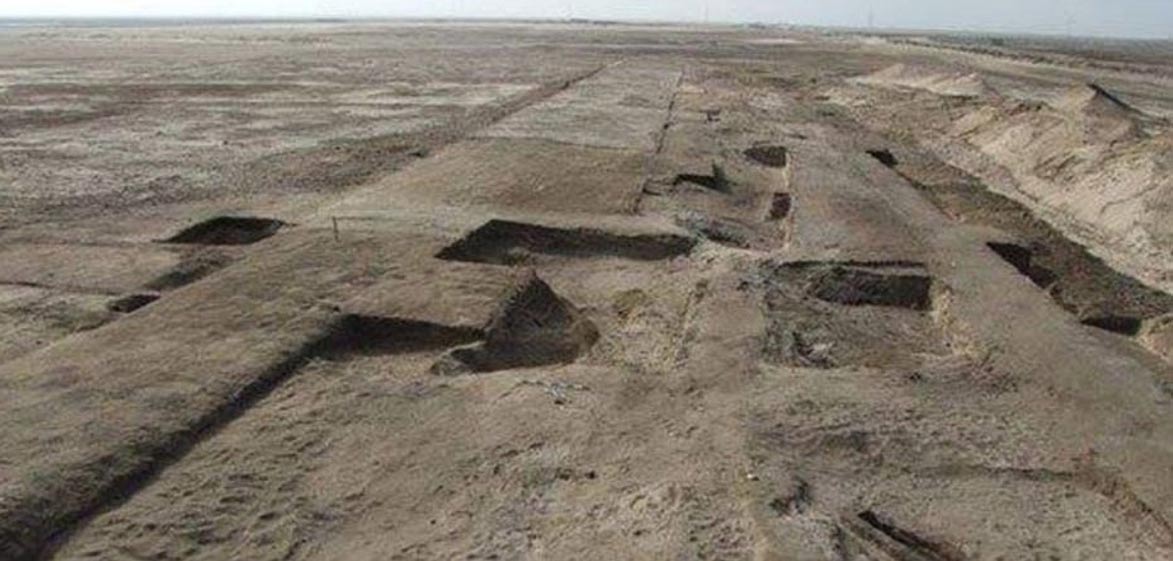Archaeological dig at ancient fortress site in Egypt reveals massive gate and graves of fallen warriors
Remnants of an ancient Egyptian army camp and mass graves containing fallen warriors have been found buried in the desert ruins site of Tjaru by a team of archaeologists.
The impressive size of the eastern gate of the ancient Tjaru fortress is revealed by the fragments uncovered at the site. Bearing inscriptions of Pharaoh Ramses II, the limestone pieces are 15 meters (49 feet) long and one meter (3 feet) wide. This massive gate secured the Way of Horus between Palestine and Egypt.

Large limestone fragments of the ancient gate at Tjaru Fortress, Egypt. Credit: Egypt Antiquities Ministry photo
Mamdouh al-Damaty, Minister of Antiquities in Egypt announced the discovery of the Egyptian army camp from the time of Thutmose III (Thutmosis) and Ramses II. The camp, located at the Tjaru Fortress in North Sinai (near present day Qantara) was led by the respective Pharaohs in the battles of Megiddo and Kadesh, reports Egypt Independent.
MORE
- 3,400-Year-Old Underwater Temple from Era of Thutmosis III Discovered near Cairo
- Newly discovered fortress on Way of Horus in Egypt stood sentinel against its enemies
- Gladiator School Discovery Reveals Hard Lives of Ancient Warriors

A bas-relief carving of Seti I and Ramses II at Abydos. A collection of reliefs of these two men was found during the recent digs around Tharu. (Wikimedia Commons photo by Kurohito)
The 3,000-year-old ruin site of Tjaru was home to an ancient fortress on the Way of Horus. Due to its remote and hostile environment it was also said to be a place of exile for criminals. The Way of Horus, or the Horus Military Road, led out of Egypt into Canaan (present day Gaza Strip). Along the route was a series of military forts with water reservoirs. These measures served as protection for ancient Egypt’s eastern borders.
“It was a key starting point for military campaigns during Egypt’s New Kingdom period (1580 B.C. – 1080 B.C.)” reports The Cairo Post.

This Google Map shows the present-day route of the ancient Horus Military Route from Qantara to Rafah. The body of water to the north is the Mediterranean Sea.
Archaeologists, working 3 kilometers (approximately 2 miles) east of the Suez Canal, also discovered several storage sites with seals bearing the name of Pharaoh Tuthmose III, as well as the graves and skeletal remains of soldiers who were killed in battle during the 26 th Dynasty.

Thutmose III smiting his enemies. Relief on the seventh pylon in Karnak. Wikipedia
Thutmose III was the sixth Pharaoh of the 18 th Dynasty. During the first 22 years of his reign, he was co-regent with his stepmother and aunt Hatshepsut, famous for taking on the male role of Pharaoh. After her death and his later rise to pharaoh of the kingdom, Thutmose III created the largest empire Egypt had ever seen, through numerous successful campaigns.
MORE
- Oldest Roman Military Camp discovered in Italy was Built to Fend off Fierce Pirates
- New Dig at First Emperor Mausoleum Expected to Yield up to 1400 More Terracotta Warriors
- The Life and Death of Ramesses II
Ramses II, the third Pharaoh of the 19 th Dynasty, came to power during his late teens after the death of Seti I, his father. His long reign of 66 years was recorded as prosperous, and at the time he was considered one of the most powerful men on earth. Ramses II undertook numerous military campaigns against neighboring regions.
The artifacts from Tjaru are set to go on display at a Military History Museum planned for the eastern bank of the Suez Canal.
Speaking earlier this year to The Cairo Post, chief of the Tjaru excavation team, archaeologist Mohammed Abdel-Maqsoud said, “The discovery is significant as it reflects the details of the ancient Egyptian military history. It is a model example of Ancient Egypt’s military architecture, as well as the Egyptian war strategies through different ages, for the protection of the entirety of Egypt.”
Featured Image: The ruins of the fortress near the ancient fortified city of Tell Habua (Tjaru) after recent excavations. Credit: Egypt Antiquities Ministry photo
By Liz Leafloor



















Comments
And more proof that the exodus is a myth ----
Why would downtrodden slaves “escape” to a PROVINCE of their Master? Palestine/Syria was all subject to Egypt at the time of the exodus. Those were the banished from power worshippers of ATEN that left the center of power for the FRINGE of the Empire, hoping to someday return to power.
Egypt reached new heights of imperial splendour and prosperity during the New Kingdom (18th - 19th dynasties). Tutmosis III campaigned beyond the EUPHRATES and reached the Fourth Cataract on the Nile; Rameses II halted the advance of the Hittites in SYRIA, which means Egypt marched ALL OVER the so-called Israeli kingdom, because Egypt OWNED PALESTINE.
Researchers believe Tjaru was a "starting point" for Egyptian military campaigns during the New Kingdom period, from 1580 B.C.E. to 1080 B.C.E., During the Middle Kingdom Period (2000 B.C. and 1700 B.C), Egypt’s military reached as far as the Tigris and Euphrates River, and supported its position with a long chain of heavily fortified settlements at the most vulnerable points in the trade route from the east, he added.
———————————————————————
Moses was “raised” as an Egyptian Prince, because Moses WAS an Egyptian Prince. As a matter of FACT, the “Hebrews” are EGYPTIAN Aten worshippers who interbred with the Native People of Palestine.
The Hebrews, the participants of the fabled Exodus, were EGYPTIAN refugee worshipers of ATEN, the MONOTHEISTIC Egyptian LIGHT God.
After Amenhotep IV aka Akenhaten elevated Aten to THE god of Egypt (THOU SHALT HAVE NO OTHER GODS BEFORE ME)
the priests of Amon and the lesser gods worked to undermine Aten. Upon the death of Pharoh Akenhaten, the “ONE” god, Aten, was
overthrown. The temples and all trace of Aten were pulled down and erased. The followers of Aten were persecuted and harrassed.
After some years of this, the followers of Aten made an “exodus” (a going out) from Egypt, to the COLONIES of Egypt in Palestine.
NOTE:
Oddly enough, Egypt reached new heights of imperial splendour and prosperity during the New Kingdom (18th – 19th dynasties). Tutmosis III campaigned beyond the EUPHRATES and reached the Fourth Cataract on the Nile; Rameses II halted the advance of the Hittites in SYRIA, which means Egypt marched ALL OVER the so-called Israeli kingdom, because Egypt OWNED PALESTINE.
Jerusalem was ruled by New Kingdom Egypt from 1550-1440 BCE.
————————————————————————–
NOTE: It is not called a HOMECOMING or RETURN, as it would have been if the participants were SEMITES originally from Palestine.
They THEMSELVES termed it an EXODUS. [EX out of, from, and HODOS, way]
This is people who WERE Egyptian and LEFT, went OUT OF the center of Egypt to seek refuge at the edges of Egypt, but still under the umbrella of Egypt.
--------------------------------------------------------------------------
The followers of Aten wandered in the desert for years (40?). They assimilated legends, myths, and People, into their Religion and Tribe.
The first generation of refugees passed on, and their religion morphed from a "loving, peace, LIGHT and enlightened god"
to a vengeful, resentful, scab-picking War god.
THIS is why there is NO Egyptian archeological evidence of a Jewish/Semitic presence OR exodus.
The Exodus consisted of EGYPTIANS leaving Egypt in the face of religious persecution that included the complete erasure of the God of the Exodus, ATEN.